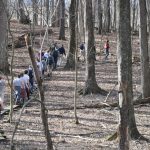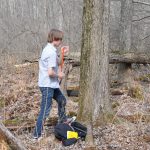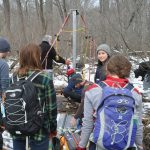Extracting a Temperature Proxy Record from Larch in Kamchatka
Abbey Martin, Sarah McGrath, Matthew Shearer, Ann Wilkinson, Vincent Hui
The purpose of this study was to analyze larch (Larix cajandery Mayr.) tree ring width from Kamchatka, Russia data to understand climate forcings. The tree ting width chronology was standardized the chronology using two methods, linear regression and negative exponential standardization, and regional curve standardization (RCS), to compare how the standardization technique influences correlations. Both standardized series were correlated with meteorological records showing high positive correlations for summer temperatures. The RCS showed stronger correlations and was used for NTREND comparison, temperature reconstruction, and spectral analysis. Together these correlations and comparisons showed the larch primarily responds to summer temperature and can be used to reconstruct summer temperatures.
Figure 1. Kamchatka Peninsula is 1600 km long and located in far east Russia. It is the home to roughly 300 volcanoes and 450 glaciers. Most of the glaciers are located along the coast, where temperature are cool. There were positive advances in glacier and moraine building at the end of the 19th century and early 20th century.
Conclusions:
1 – The Kamchatka larch tree-ring widths are a good proxy to reconstruct summer temperatures due to their high positive correlation.
2 – We recommend the RCS method for climate response analysis since the RCS method showed higher correlations.
3 – The RCS series showed similar trends as the NTREND series, suggesting the Kamchatka site follows the same climate signals as the rest of the northern hemisphere.
4 – Temperature reconstruction shows a general increase in temperature over the last 350 years.
References:
Frederick, S., 2014, Coring Across Kamchatka: Wooster Geologists: http://woostergeologists.scotblogs.wooster.edu/tag/russia/ (accessed April 2016).
Solomina, O., Wiles G., Shiraiwa, T., Arrigo, R.D., 2007, Multiproxy Records of Climate Variability for Kamchatka for the Past 400 Years: Climate of the Past: http://www.clim-past.net/3/119/2007/cp-3-119-2007.pdf (accessed April 2016)
Wilson, R., Anchukaitis, K., Briffa, K., Büntgen, U., Cook, E., D’ Arrigo, R., Davi, N., Esper, J., Frank, D., Gunnarson, B., Hegerl, G., Helama, S., Klesse, S., Krusic, P., Linderholm, H., Myglan, V., Osborn, T., Rydval, M., Schneider, L., Schurer, A., Wiles, G., Zhang, P. and Zorita, E., 2016, Last millennium Northern Hemisphere summer temperatures from tree rings: Part I: the long-term context: Quaternary Science Reviews (2016), pp. 1-18 DOI information: 10.1016/j.quascirev.2015.12.005
Solomina, O.N., Bradley, R.S., Hodgson, D.A., Ivy-Ochs, S., Jomelli, V., Mackintosh, A.N., Nesje, A., Owen, L.A., Wanner, H., Wiles, G.C., Young, N.E ., 2015, Holocene glacier fluctuations: Quaternary Science Reviews, doi:10.1016/j.quascirev.2014.11.018.
A reconstruction of past climate using data from Johnson Woods
Sharron Osterman, Annette Hilton, Cameron Steckbeck, Gina Malfatti, Amineh AlBashaireh
- Climate is one of the most popular topics among scientists today, both how climate has changed and how it will continue to change
- Dendroclimatology, or using trees as a proxy for climate, can be used to learn about past, present, and future climates
- Using tree cores from Johnson Woods (JW) graphs and spatial correlations were constructed to track precipitation (PPT) and temperature (T) going back to the 1600.


 JW ring width (std), standardized using RCS, and data from NTREND (C). RCS preserves low frequency signals, including potential climate signals.
JW ring width (std), standardized using RCS, and data from NTREND (C). RCS preserves low frequency signals, including potential climate signals.
Conclusions
- For JW, tree chronologies can be used as a proxy for PPT
- JW correlates positively with PPT May-July
- JW correlates negatively with temperature for May-July
- Spectral analysis used to identify cycles that may impact JW, such as solar radiance (11 yrs), tidal cycle (18 yrs)
- Marker years of growth anomalies correlate to climate conditions, such as the drought of 1895
The class mills around the gas power plant – most of these students have seen the transition of a coal burning plant to a gas during plant – the carbon dioxide emissions on campus have been cut in half. However, now the College buys its power for cooling (air conditioning) off campus from the grid, mostly powered by coal, however it is getting better and we will get there in time. (special thanks to Lanny Whitaker who showed us the plant and where our energy comes from – thank you).










